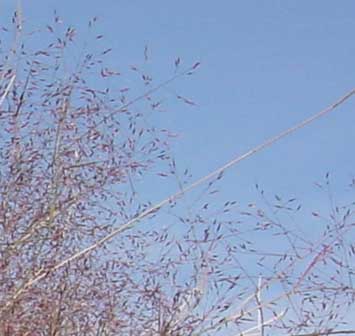
Bush Muhly (Muhlenbergia porteri)
Main Sources: Gould, Frank, 1951, Grasses of the Southwestern United States, Tucson: University of Arizona Press; Shreve, Forrest & Ira Wiggins, 1964, Vegetation and Flora of the Sonoran Desert, Vol. 1, Palo Alto: Stanford University Press; Kearney, Thomas & Robert Peebles, et al., 1960, Arizona Flora, Berkeley: University of California Press; McClaran, Mitchel & Thomas Van Devender, 1995, The Desert Grassland, Tucson: University of Arizona Press; van Devender, Thomas & Mark Dimmitt, "Desert Grasses", in Phillips, Steven & Patricia Comus, eds., 2000, A Natural History of the Sonoran Desert, pp. 265-80, Arizona-Sonora Desert Museum Press, Tucson; Ruyle, George & Deborah Young, eds., 1997, Arizona Range Grasses, Tucson, University of Arizona College of Agriculture; USDA Conservation Districts of Southeastern Arizona, n.d., Grasses of Southeastern Arizona. Washington, D.C.
This important native grass is described as a "large, weak-stemmed, fine perennial bunchgrass" which has a hard, knotty base and forms a tangled leafy mass 1 to 3 feet tall. Its stems are slender and wiry, multi-branched, with many nodes, and the leaves are short, flat, or folded. The color is purplish-green early in the season, curing to buff/purple (photo above was taken in October). The stems of Bush Muhly are leafy over their entire length. The inflorescence is a "fine, many-branched panicle", spreading widely, with "one prominently awned floret per spikelet" (USDA, cited above, #27). See the images below: (and click on each image to enlarge it)
 ..
..
Found on dry mesas and rocky slopes from 2,000 to 6,000 feet, it is highly palatable to all kinds of livestock, and was formerly one of the most abundant grasses of Southern Arizona (at one time it was harvested by settlers with hoes -- one of its popular names being "Hoe Grass"), but it is mostly found today as scattered individual plants and usually growing protected among shrubs (like Shindagger Agave, Creosotebush, or Mesquite trees). The in-the-open individual shown above is quite unusual in our area today.
As we explore our lands in more detail, we do find clumpings of it occasionally, for example on a lower slope of one of our Northeast corner ridges, right around 4,000 feet, in early April 2004 (after good rains) we saw several fresh-growing clumps of this size, below:

Back to Grasses